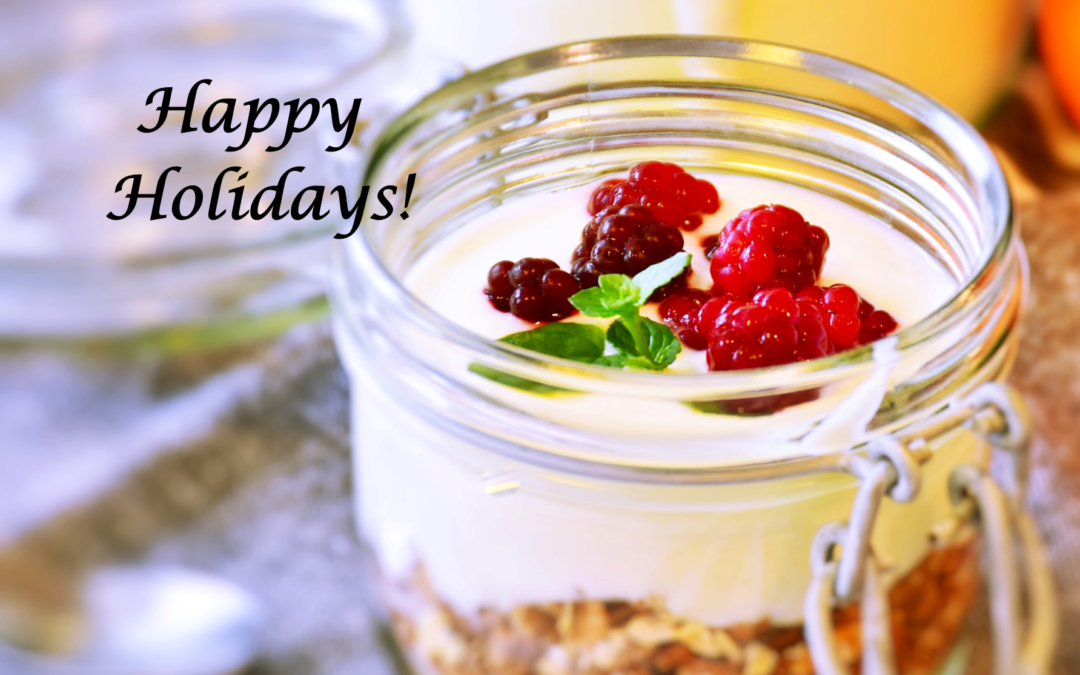Happy Holidays!
Gut microbiota plays important roles not just in our digestive function and gut health, but also in many other body functions, including immune function, brain and nervous system function, metabolic function, etc.
The important roles gut microbiota play in our health can be reflected in the many chronic diseases and disorders associated with imbalanced gut microbiota. These include:1–5
- Obesity
- Metabolic disorders
- Nonalcoholic fatty liver disease
- Nonalcoholic steatohepatitis
- Type 2 diabetes
- Irritable bowel syndrome
- IBD
- Colorectal cancer
- Cognitive/psychiatric/neurological disorders such as autism spectrum disorders, anxiety, depression, schizophrenia, and Parkinson’s disease.
See more details in our previous articles: “Why Your Gut Feeling Matters”, “You Are What You Eat? Not Quite”.
Frequent consumption of probiotic foods such as yogurt, sauerkraut, kimchi etc. can promote a healthy gut microbiota.
Store-bought yogurt can be filled with food additives such as starch, gum, sweeteners, calcium salt, etc.
Why not treat yourself and your gut microbiota with some delicious homemade coconut yogurt that is dairy free and soy free, and made with very simple and nourishing ingredients?
I provided here two versions of the recipe. The first version is made with fresh young coconut, which is hands down my favorite one as the taste of fresh young coconut is so refreshing. The resulted yogurt tastes far better than any store-bought coconut yogurt that I have tried (in my humble opinion). 😊
The second version is made with canned coconut milk, which is more convenient if you don’t have easy access to fresh young coconut. It is also less labor work as you don’t have to open the coconut and extract the coconut meat.
Hope you enjoy the recipes below!
Recipe #1: Homemade Coconut Yogurt (Made With Fresh Young Coconut)
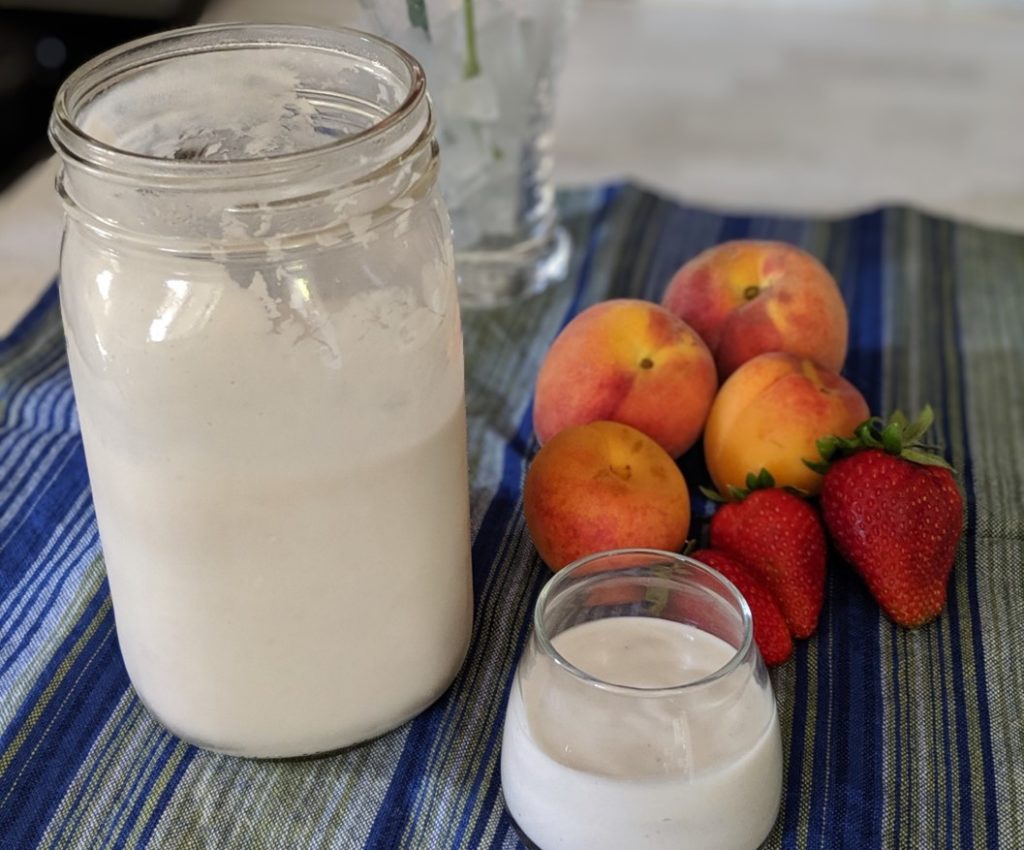
You can find fresh young coconuts in Asian grocery stores and nowadays they can also be found at regular grocery stores such as Whole Foods and Sprouts.
Please make sure to buy the ones with white (or green) outer layer (see the left photo below) instead of brown outer layer (see the right photo below) which are fully ripe coconuts.
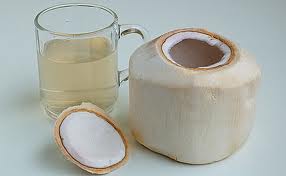
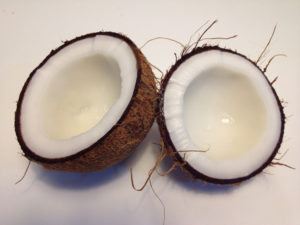
You will need to crack open the coconut to extract the coconut water and meat. You can do that at home if you have the appropriate tool or you can try to request someone at the grocery store to open it for you.
Once you have opened the coconut, pour out the coconut water into a container and then use a sturdy spoon (e.g. stainless-steel spoon) to extract the coconut meat.
Here is the list of ingredients and preparation steps:
Basic ingredients:
(This makes about 3 cups of yogurt)
- 2 fresh young coconuts
- 1 serving of probiotic capsule(s)
- Tips: 1 serving is the suggested dosage of the probiotic supplement written on the supplement container.
- Optional: 1 serving of prebiotic powder or capsule
- Tips: Adding prebiotic can enhance the fermentation process of the probiotic bacteria.
- Tips: 1 serving is the suggested dosage of the prebiotic supplement written on the supplement container.
- Tips: The prebiotic supplement I use is Body Ecology’s EcoBloomTM
Preparation steps:
-
- Extract coconut water and meat from the fresh young coconuts and put in separate containers.
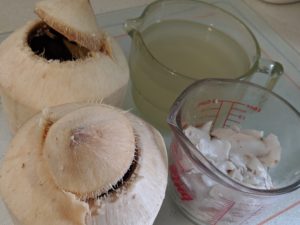
- Put all the extracted coconut meat into a high-speed blender (I have a Vitamix).
- Pour enough coconut water into the high-speed blender until it completes covers all the coconut meat but not by a lot (e.g. the water level should be ½ inch or less above the coconut meat).
- Optionally, if you use prebiotic powder/capsule, add the prebiotic powder or open the capsule to pour out the powder into the mixture in the high-speed blender.
- Blend the mixture in high speed until everything is fully blended and until the temperature of the mixture is about 92˚F.
- Tips: Bringing the temperature to around 92˚F helps to activate the fermentation process.
- Tips: Use a food thermometer to check the temperature of the mixture. Alternatively, you can wash your hands well and dip your finger into the mixture to test the temperature. It should feel slightly warm, close to but below normal body temperature.
- Pour the mixture into a glass container (I use a quart size mason jar).
- Open the probiotic capsule(s) and pour the powder into the mixture, then use a non-metal spoon to stir until the probiotic powder is well blended in.
- Cover the glass container with a non-metal lid (do not tighten the lid) or a clean cheesecloth and put the container into the oven, with the oven light turned on to keep a warm temperature inside the oven.
- Tips: Keeping the temperature slightly above room temperature can speed up the fermentation process. Please make sure not to turn on the oven, just turn on the oven light.
- Tips: If you have a yogurt making machine, you can certainly use that instead.
- Let the mixture ferment for 6-8 hours before removing it from the oven. Then leave the yogurt mixture on the counter at room temperature for about 1 hour.
- Tips: The fermentation time can vary depending on the room temperature in the house. It will take shorter time in the summer compared to the winter. From time to time, you can take the container out from the oven and sample the yogurt mixture with a clean spoon to check for the taste. Once it reaches your preferred tanginess, you can stop the fermentation process.
- Tighten the container lid and store the yogurt in the refrigerator overnight before consumption. The yogurt should keep well for several days.
- Extract coconut water and meat from the fresh young coconuts and put in separate containers.
Some further tips:
- To minimize the chance of mold or growing of undesirable bacteria during the fermentation process, make sure to sterilize all the utensils and containers including the high-speed blender container before use. You can use boiling water to rinse the utensils and containers for this purpose and then dry them before use.
- Adjust the amount of coconut water to use based on the consistency of the yogurt you prefer. The less coconut water you use, the thicker the consistency. Note that unlike dairy based yogurt, non-dairy yogurt does not thicken too much during fermentation process. Refrigeration will further thicken the yogurt.
- During the fermentation process or when storing in the refrigerator, if you see mold or weird colors, or smell odd or off-putting odor from the yogurt, this is a sign that bad bacteria or fungi has overtaken the colony. Please discard the yogurt. Note that so far this has not happened to me.
Recipe #2: Homemade Coconut Yogurt (Made With Canned Coconut Milk)
Canned coconut milk is usually made from fully ripe coconut. Ripe coconut has higher oil content than young coconut. The resulted coconut yogurt is thicker in consistency and tastes somewhat different from and heavier than the one made with fresh young coconut.
Basic ingredients:
(This makes about 3 cups of yogurt)
- 2 14-ounce cans full fat coconut milk
- Tips: Choose organic canned coconut milk and the ones with minimum or no additives.
- Tips: You can use coconut cream instead of coconut milk for a thicker and richer consistency.
- 1 serving of probiotic capsule(s) (see further description in Recipe #1 above)
- Optional: 1 serving of prebiotic powder or capsule (see further description in Recipe #1 above)
Preparation steps:
-
- Shake the canned coconut milk well before opening the cans.
- Open the cans and pour the coconut milk into a glass container (I use a quart size mason jar).
- Follow steps 7-10 in Recipe #1 above.
Some further tips:
- See the further tips described in Recipe #1.
- To better kick-start the fermentation process, as previously described in Recipe #1, you can certainly warm up the coconut milk on stove top to about 92˚F before pouring it into a glass container.
Some Suggestion to Enjoy Your Homemade Coconut Yogurt
Now that you have your tasty homemade coconut yogurt, you can dress it up to your liking!
For the yogurt made with fresh young coconut, I usually do not add further sweetener as the coconut water provides a sweet and refreshing taste. Just by adding sweet fruits such as berries, peaches, etc. provides sufficient sweet taste for me.
If it is wintertime or cold weather at where you live, adding some warming and aromatic spices can be a nice treat and balance out the cooling nature of yogurt. I like to sprinkle ground cinnamon, cardamom and nutmeg to my yogurt. You can also add some pumpkin pie spice to celebrate the festive and holiday season.
Enjoy!
Related Articles
You Are What You Eat? Not Quite
References
- Quigley EMM. Gut bacteria in health and disease. Gastroenterol Hepatol (N Y). 2013;9(9):560-9.
- Julio-Pieper M, Bravo J, Aliaga E, Gotteland M. Review article: intestinal barrier dysfunction and central nervous system disorders – a controversial association. Aliment Pharmacol Ther. 2014;40(10):1187-1201. doi:10.1111/apt.12950
- Mayer E, Tillisch K, Gupta A. Gut/brain axis and the microbiota. Journal of Clinical Investigation. 2015;125(3):926-938. doi:10.1172/jci76304
- Nair AT, Ramachandran V, Joghee NM, Antony S, Ramalingam G. Gut Microbiota Dysfunction as Reliable Non-invasive Early Diagnostic Biomarkers in the Pathophysiology of Parkinson’s Disease: A Critical Review. J Neurogastroenterol Motil. 2018;24(1):30-42.
- Mirjana R. Function of the microbiota. Best Pract Res Clin Gastroenterol. 2013;27(1):5-16. doi:10.1016/j.bpg.2013.03.006

